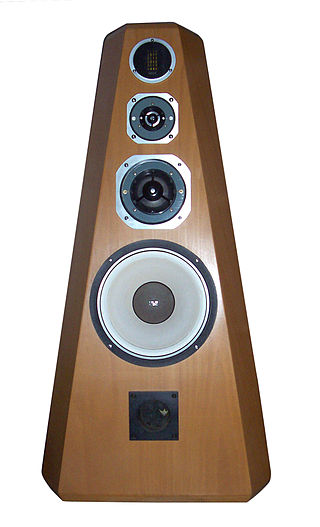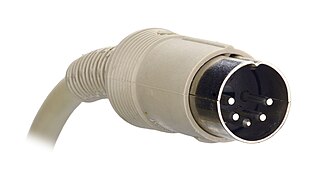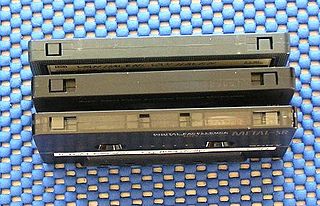
High fidelity is the high-quality reproduction of sound. It is popular with audiophiles and home audio enthusiasts. Ideally, high-fidelity equipment has inaudible noise and distortion, and a flat frequency response within the human hearing range.

In signal processing, pre-emphasis is a technique to protect against anticipated noise. The idea is to boost the frequency range that is most susceptible to noise beforehand, so that after a noisy process more information can be recovered from that frequency range. Removal of the distortion caused by pre-emphasis is called de-emphasis, making the output accurately reproduce the original input.

An audiophile is a person who is enthusiastic about high-fidelity sound reproduction. An audiophile seeks to reproduce recorded music to achieve high sound quality, typically in a quiet listening space and in a room with good acoustics.

The RCA connector is a type of electrical connector commonly used to carry audio and video signals. The name RCA derives from the company Radio Corporation of America, which introduced the design in the 1930s. The connector’s male plug and female jack are called RCA plug and RCA jack.
A cassette deck is a type of tape machine for playing and recording audio cassettes that does not have a built-in power amplifier or speakers, and serves primarily as a transport. It can be a part of an automotive entertainment system, a part of a portable mini system or a part of a home component system. In the latter case it is also called a component cassette deck or just a component deck.

A phonograph record, a vinyl record, or simply a record or vinyl is an analog sound storage medium in the form of a flat disc with an inscribed, modulated spiral groove. The groove usually starts near the periphery and ends near the center of the disc. For about half a century, the discs were commonly made from shellac, with earlier records having a fine abrasive filler mixed in. Starting in the 1940s, polyvinyl chloride (PVC) became common, the "vinyl records" of the late 20th century.

The DIN connector is an electrical connector that was standardized by the Deutsches Institut für Normung (DIN), the German Institute for Standards, in the mid 1950's, initial with 3 pins for mono, but when stereo connections and gear appeared in late 1950's, versions with 5 pins or more were launched. The male DIN connectors (plugs) feature a 13.2 mm diameter metal shield with a notch that limits the orientation in which plug and socket can mate. The range of DIN connectors, different only in the configuration of the pins, have been standardized as DIN 41524 / IEC/DIN EN 60130-9 ; DIN 45322 ; DIN 45329 / IEC/DIN EN 60130–9 ; and DIN 45326 / IEC/DIN EN 60130-9.
PS Audio is an American company specializing in high-fidelity audio components equipment for audiophiles and the sound recording industry. It currently produces audio amplifiers, preamplifiers, power related products, digital-to-analog converters, streaming audio, music management software and cables.
Tone control is a type of equalization used to make specific pitches or frequencies in an audio signal softer or louder. It allows a listener to adjust the tone of the sound produced by an audio system to their liking, for example to compensate for inadequate bass response of loudspeakers or earphones, tonal qualities of the room, or hearing impairment. A tone control circuit is an electronic circuit that consists of a network of filters which modify the signal before it is fed to speakers, headphones or recording devices by way of an amplifier. Tone controls are found on many sound systems: radios, portable music players, boomboxes, public address systems, and musical instrument amplifiers.

An audio/video receiver (AVR) is a consumer electronics component used in a home theater. Its purpose is to receive audio and video signals from a number of sources, and to process them and provide power amplifiers to drive loudspeakers and route the video to displays such as a television, monitor or video projector. Inputs may come from a satellite receiver, radio, DVD players, Blu-ray Disc players, VCRs or video game consoles, among others. The AVR source selection and settings such as volume, are typically set by a remote controller.
Dynagroove is a recording process introduced in 1963 by RCA Victor that, for the first time, used analog computers to modify the audio signal used to produce master discs for LPs. The intent was to boost bass on quiet passages, and reduce the high-frequency tracing burdens (distortion) for the less-compliant, "ball" or spherical-tipped playback cartridges then in use. With boosted bass, tracing demands could be reduced in part by reduced recording levels, sometimes supplemented by peak compression. This added top-end margin permitted selective pre-emphasis of some passages for greater perceived (psychological) brilliance of the recording as a whole. As with any compander, the program material itself changed the response of the Dynagroove electronics that processed it. But, because the changes were multiple and algorithmic, RCA justifiably referred to the analog device as a computer.
Phono input is a set of input jacks, usually mini jacks or RCA connectors, located on the rear panel of a preamp, mixer or amplifier, especially on early radio sets, to which a phonograph or turntable is attached.
Record restoration, a particular kind of audio restoration, is the process of converting the analog signal stored on gramophone records into digital audio files that can then be edited with computer software and eventually stored on a hard-drive, recorded to digital tape, or burned to a CD or DVD. The process may be divided into several separate steps performed in the following order:
- Cleaning the record, to prevent unwanted audio artifacts from being introduced in the capture that will necessitate correction in the digital domain, and to prevent unnecessary wear and damage to the stylus used in playback.
- Transcription of the record to another format on another medium ;
- Processing the raw sound file with software in order to remove transient noise resulting from record surface damage ;
- Using software to adjust the volume and equalization;
- Processing the audio with digital and analogue techniques to reduce surface/wideband noise;
- Saving the file in the desired format.
The AES coarse-groove calibration discs (AES-S001-064) are a boxed set of two identical discs, one for routine use, one for master reference. The intent is to characterize the reproduction chain for the mass transfer of coarse-groove records to digital media, much like using a photographic calibration reference in image work.
A smiley face curve or mid scoop in audio signal processing is a target frequency response curve characterized by boosted low and high frequencies coupled with reduced midrange frequency power. This curve is often attained by users employing a graphic equalizer, which shows a graphic representation of a "smile" using its frequency band faders to form a curve that sweeps upwards at each end of the frequency spectrum. Smiley face curves have been popular with some car audio enthusiasts, disc jockeys, electric bass players, home stereo owners and sound reinforcement operators. Though the graphic equalizer was intended to tailor a system's response to compensate for venue and performance conditions, the smiley face curve is sometimes applied as a purely stylistic effect.

The TRM-800 was a high-end solid state integrated stereo amplifier made in Japan, using NEC power transistors, by Nikko. It was the top-of-the-line model in the Nikko amplifier range of TRM's series; housed in a wooden walnut-finished cabinet and a brushed aluminum front panel, was introduced in 1975 the same year as the Marantz 2235. It was a two-channel amp; however, it had three sets of speaker connections; those powered selected by buttons. At 8 ohms, the amp could put out 65 Watts per channel RMS, delivering superb high fidelity sound with exceptional tone quality. Unlike many amps of this time, however, the TRM-800 was stable at lower impedances than 8 ohms; down to 4 ohms. The TRM-800's frequency response ranges 10Hz to 40.000 Hz ±1 dB with T.H.D. less than 0.1% at rated output. Its preamplifier and main amplifier were separable for multi-channel amplifier systems. The amp has internal circuit breakers which prevent it from clipping or overheating. Its power consumption is 250 watts. For equalization it has only a bass and a treble knob; however the frequency of these are selectable; between 250 and 500 Hertz for the bass, and between 2.5 and 5 kHz for the treble. It also has a high, low, and a subsonic filter. There are two phono stages; phono 2 is provided with impedance matching selection, for using different types of cartridges (MC/MM).

Equalization, or simply EQ, in sound recording and reproduction is the process of adjusting the volume of different frequency bands within an audio signal. The circuit or equipment used to achieve this is called an equalizer.

Compatible Discrete 4, also known as Quadradisc or CD-4 was a discrete four-channel quadraphonic system for phonograph records. The system was created by JVC and RCA in 1971 and introduced in May 1972. Hundreds of recordings using this technology were released on LP during the 1970s.

Audio compact cassettes use magnetic tape of three major types which differ in fundamental magnetic properties, the level of bias applied during recording, and the optimal time constant of replay equalization. Specifications of each type were set in 1979 by the International Electrotechnical Commission (IEC): Type I, Type II, Type III, and Type IV. 'Type 0' was a non-standard designation for early compact cassettes that did not conform to IEC specification.
In magnetic tape recording, adaptive biasing is the technique of continuously varying the bias current to a recording head in accordance with the level of high-frequency audio signals. With adaptive biasing, high levels of high-frequency audio signals cause a proportionate decrease in bias current using either feedforward or preferably a negative feedback control system. Compared with the use of fixed bias current, adaptive biasing provides a higher maximum output level and higher dynamic range at the upper end of the audible spectrum and to a lesser extent, mid-range frequencies. The effect of adaptive biasing is most pronounced in compact cassette and low-speed reel-to-reel media. The first commercial implementation, the feedforward system Dolby HX was developed by Dolby Laboratories by 1979 and was rejected by the industry. The subsequent negative-feedback system Dolby HX Pro was developed by Bang & Olufsen and marketed by Dolby, and became the de facto standard of the consumer high fidelity industry in the mid-1980s.












